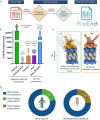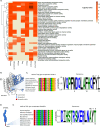This is a preprint.
ProEnd: A Comprehensive Database for Identifying HbYX Motif-Containing Proteins Across the Tree of Life
- PMID: 38895466
- PMCID: PMC11185799
- DOI: 10.1101/2024.06.08.598080
ProEnd: A Comprehensive Database for Identifying HbYX Motif-Containing Proteins Across the Tree of Life
Update in
-
ProEnd: a comprehensive database for identifying HbYX motif-containing proteins across the tree of life.BMC Genomics. 2024 Oct 13;25(1):951. doi: 10.1186/s12864-024-10864-4. BMC Genomics. 2024. PMID: 39396964 Free PMC article.
Abstract
The proteasome plays a crucial role in cellular homeostasis by degrading misfolded, damaged, or unnecessary proteins. Understanding the regulatory mechanisms of proteasome activity is vital, particularly the interaction with activators containing the hydrophobic-tyrosine-any amino acid (HbYX) motif. Here, we present ProEnd, a comprehensive database designed to identify and catalog HbYX motif-containing proteins across the tree of life. Using a simple bioinformatics pipeline, we analyzed approximately 73 million proteins from 22,000 reference proteomes in the UniProt/SwissProt database. Our findings reveal the widespread presence of HbYX motifs in diverse organisms, highlighting their evolutionary conservation and functional significance. Notably, we observed an interesting prevalence of these motifs in viral proteomes, suggesting strategic interactions with the host proteasome. As validation two novel HbYX proteins found in this database were tested and found to directly interact with the proteasome. ProEnd's extensive dataset and user-friendly interface enable researchers to explore the potential proteasomal regulator landscape, generating new hypotheses to advance proteasome biology. This resource is set to facilitate the discovery of novel therapeutic targets, enhancing our approach to treating diseases such as neurodegenerative disorders and cancer. Link: http://proend.org/.
Figures




Similar articles
-
ProEnd: a comprehensive database for identifying HbYX motif-containing proteins across the tree of life.BMC Genomics. 2024 Oct 13;25(1):951. doi: 10.1186/s12864-024-10864-4. BMC Genomics. 2024. PMID: 39396964 Free PMC article.
-
Minimal mechanistic component of HbYX-dependent proteasome activation that reverses impairment by neurodegenerative-associated oligomers.Commun Biol. 2023 Jul 14;6(1):725. doi: 10.1038/s42003-023-05082-9. Commun Biol. 2023. PMID: 37452144 Free PMC article.
-
Minimal mechanistic component of HbYX-dependent proteasome activation.Res Sq [Preprint]. 2023 Mar 20:rs.3.rs-2496767. doi: 10.21203/rs.3.rs-2496767/v1. Res Sq. 2023. Update in: Commun Biol. 2023 Jul 14;6(1):725. doi: 10.1038/s42003-023-05082-9. PMID: 36993338 Free PMC article. Updated. Preprint.
-
Oxidative protein damage and the proteasome.Amino Acids. 2012 Jan;42(1):23-38. doi: 10.1007/s00726-010-0646-8. Epub 2010 Jun 17. Amino Acids. 2012. PMID: 20556625 Review.
-
Modulating the Ubiquitin-Proteasome System: A Therapeutic Strategy for Autoimmune Diseases.Cells. 2022 Mar 24;11(7):1093. doi: 10.3390/cells11071093. Cells. 2022. PMID: 35406655 Free PMC article. Review.
References
-
- Glickman M. H. & Ciechanover A. The ubiquitin-proteasome proteolytic pathway: Destruction for the sake of construction. Physiol. Rev. 82, 373–428 (2002). - PubMed
-
- Bennett E. J., Bence N. F., Jayakumar R. & Kopito R. R. Global impairment of the ubiquitin-proteasome system by nuclear or cytoplasmic protein aggregates precedes inclusion body formation. Mol. Cell 17, 351–365 (2005). - PubMed
Publication types
Grants and funding
LinkOut - more resources
Full Text Sources
Research Materials
